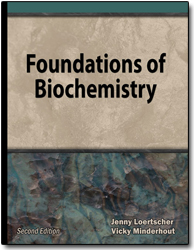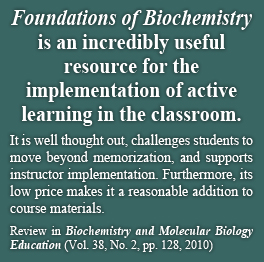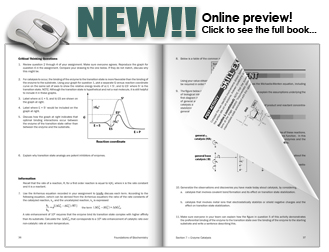 |
Exemplifying
many of the best practices in science
education,
Foundations of Biochemistry
encourages students to explore the synergy
of working and solving problems in groups.
The 36 activities in the POGIL-oriented
workbook “cover the gamut of topics
typically covered in a Biochemistry course,”
according to a review by Ann Taylor in
Biochemistry and Molecular Biology Education
(Vol. 38, No. 2, pp. 128, 2010).
“Each
activity has three main components,”
continues Taylor, “a pre-class assignment,
an in-class assignment, and a post-class
skill exercise.” The post-class activities
encourage students to apply the skills in
new ways, and to solve problems.
|
Following the POGIL
method, the instructor facilitates the learning and
encourages students without using lecture, “helping
the students ‘see the forest for the trees,’”
according to Mark T. Werth in Chemical Education
Today (Vol. 87, No. 8, pp. 787-789, August
2010). Werth reports that the activities helped
students to engage with the material at a deeper
level, resulting in a longer discussion than usual
“because the students were now prepared to ask
really good questions during the lecture.”
|
Werth
administered an anonymous survey in which his
students reported that “the POGIL exercises helped
them to apply what they were learning and that they
learned better by actually doing.”
Foundations of Biochemistry introduces
students to the POGIL method by explaining that the
study of biochemistry is largely about practicing
and applying the skills that students already have.
Authors Loertscher and Minderhout explain: “Although
the sheer scope of the field of biochemistry may
seem overwhelming to learn, you will quickly
discover that you already have had experience with
many of the concepts you will encounter... by
actively engaging with the material, you will build
your understanding of biochemical concepts while
simultaneously gaining problem solving and critical
thinking skills.”
|
 |
 |
To support
instructors, there is an Instructor’s
Resources web site that includes keys to the
Assignments, Activities, and Skill
Exercises. The addition of Facilitation
Plans, Data Sheets and a Universal Report
form will help instructors make the most of
this book.
For more information, including a
preview of the full book, visit
http://www.pcrest2.com/biochemistry
You can also view other great POGIL
and
active learning workbooks at
http://www.pcrest.com
|
|


